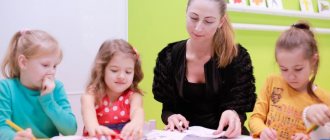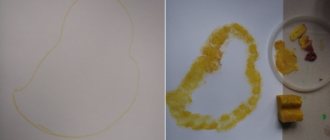Musical and didactic game for children 3 - 6 years old “Hen with Chicks”
Musical and didactic game “Hen with Chicks”
Description of material: I present to your attention a musical and didactic game for the development of phonemic hearing. The game can be used in work with children of primary preschool age, with complications - for children of middle and senior preschool age. The manual may be useful to preschool teachers, speech therapists, and parents of preschool children. Goal: development of phonemic hearing in preschool children. Objectives : - improve mental processes: logical thinking, the ability to identify a common feature by the sound of a game object, voluntary attention and memory; - develop recognition of non-speech sounds; - develop sound-frequency auditory perception, phonemic memory; - form game actions, - cultivate focus, desire to achieve a positive result, interest in activities.
For the development of all speech functions (perception, sound pronunciation, speech acquisition, and later reading and writing), a well-developed phonemic hearing is necessary. The formation of phonemic hearing in children is carried out in stages. Psychologists have proven that even infants can guess and distinguish the general intonation and its rhythm. And by the age of two, the child is able to perceive all the subtleties of the speech environment. In pedagogy and speech therapy, special exercises have been developed and successfully used in practice to form non-speech sound discrimination. It is necessary to take these exercises seriously, pay sufficient attention to them and not forget that the activities should be desirable and interesting for children. The best way to do this is in game. To make a game aid you will need: ten containers from small Kinder surprises; for filling them: beans, semolina, buckwheat, beads, bells; one container from a large kinder surprise; crochet hook, yellow yarn (for making a chicken - additionally red threads - for a scallop and any other two or three colors), red felt, eyes - twenty small and two large. Description of the method for making the manual: The game is made in the form of a flower meadow on which a hen and chicks are sitting. Containers for small kinder surprises are filled with cereals, beads, bells (two containers each with the same contents). To make chicks, containers are crocheted with yellow yarn, beaks are sewn on from pieces of felt, and eyes are inserted or glued. To decorate the chicken, additionally use colored yarn and knit a red comb.
Progress of the game:
(younger preschool age) In the game for the development of non-speech sound discrimination in children of primary and secondary preschool age, it is more advisable to use individual work: in conjunction with a child teacher. Young children are offered no more than two pairs of rattle chicks, which differ sharply in sound. The child selects chickens that have the same sound.
(middle preschool age) Gradually, the number of pairs of sounding chicken toys increases (from two to five pairs). The difference in sound becomes less noticeable and requires the greatest auditory concentration for differentiation. (senior preschool age) Children can participate in the game without pedagogical support, independently, according to the child-child model.
In addition, children can be offered an option when one of the participants in the game closes his eyes (or turns away), and the second participant, the presenter, “makes” a sound task for him: he rattles a rattle and puts it behind his back. The answerer must remember and correctly find which chicken has the same sound as the one in question. This version of the game stimulates the development of phonemic memory. Summarizing:
the game ends when each chicken is matched with a pair that is absolutely similar in sound. Our yellow chickens are very nice guys! Beak, eyes, crest And a special voice. Here are the boy chicks.
Here are the chick girls.
And each couple has different chants. A couple of quiet ones, a couple of loud ones, and then there are a couple of loud ones. The mother hen knows the voices of the children: And the girl chicks And the boy chicks. Chickens have scattered across our clearing, they are mischievous, running and playing hide and seek.
We will help the chicken collect the babies, The main thing is for us to recognize the pair's Voice. We will take the chickens in our hands, rattle them, put them to their ears - We will definitely find a pair for each rattle! (Poems by the author)
We recommend watching:
Didactic game on sensory skills for kindergarten Games for the development of fine motor skills in the younger group Games for the development of air flow Didactic game for children 3-4 years old “Vegetable garden”
Similar articles:
Do-it-yourself didactic games for preschoolers on the topic “Sense Organs”
DIY didactic game for preschoolers. World of flora and fauna
Do-it-yourself didactic game for kindergarten on the topic “Transport”
DIY didactic game for preschoolers
Didactic game for children 4-7 years old “Fairytale Hotel”
Physical education leisure “Hen with chicks” 2nd junior groupmaterial (junior group) on the topic
2nd junior group
Physical education “Hen with chicks”
Objectives: strengthen the ability to navigate in space; develop dexterity and coordination in the game “Catch a Mosquito”. Cultivate endurance, attention, and the ability to respond to signals. Create a positive emotional mood in children, arouse interest in physical exercise.
Equipment: chicken cape, cat mask, hoops according to the number of children, fishing rod with a mosquito, chicken toy.
Before leisure time, the teacher hides a toy chicken in the hall.
Teacher: Hello guys, today we will play with you. You will be little chickens, and I will be your mother Hen.
Fly to me quickly, my chickens! Let's go for a walk, on the lawn, stand one after another. Walking in a column one at a time, “flapping your wings.”
Oh, what a beautiful lawn, the grass is green, the dandelions are yellow, just like my chickens! “The mother hen dozed off in the sun, and the naughty chickens ran away in all directions. (Running in all directions). Teacher: Where, where, where, where! Come on, come on, everyone here!
Quickly come under your mother's wing! Where have you gone?! (V. Berestov)
Everybody hurry up and run to me,
And walk in a column one after another. Children stand in a column, the game is repeated.
What naughty people! Now stand in a circle and let’s do chicken exercises. (dosage 4-5 times) 1. “CHICKENS FLAPPING THEIR WINGS” I.P.: legs in a narrow path, arms down. Raise your arms to the sides and lower them.
2. “CHICKENS DRINK WATER” IP: legs in a narrow path, arms down. Bend forward, arms back. 3. “ROW WITH YOUR FEET, LOOK FOR GRAINS” I.P.: legs in a narrow path, hands on the belt. Leg forward, backward. Same with the other leg
4. “CHICKENS PECK THE GRAINS” I.P.: main stand. Sit down and tap your fingers on the floor several times. 5 “CHICKENS FLY” IP: legs together, arms down. Jumping on two legs, with arm swings alternating with walking. 2 times
How the air smells on the lawn! Take a sniff, chickens. (breathing exercise: inhale through the nose, exhale through the mouth).
ACTIVE GAME "CHICKENS AND CAT".
One of the children puts on a cat mask. A hen walks with her baby chicks.
On the bench by the window the cat opens its eyes
The cat has settled down and is dozing. And the chickens catch up.
At the last words, the chickens run away from the cat, and she tries to catch up with them.
The hen hides the chickens - the teacher spreads his arms to the sides, the chickens run to the hen and hide under the wing. The game is repeated 2-3 times
GAME “CHICKENS IN THE HOUSE”
On one side of the hall, hoops are laid out for each child. Children stand in the “house” hoop one at a time. At the signal “The chickens have flown onto the lawn,” children jump out of the hoops and run with their arms at their sides. At the signal “Chicks go home,” all players run to the hoops and occupy any hoop. After one repetition, several hoops are removed until one “chicken” remains in the house.
GAME “CATCH A MOSQUITO”
Children stand in a circle at arm's length, facing the center of the circle. The teacher is in the middle of the circle, holding a 1-1.5 m “fishing rod” with a paper “mosquito” tied to a cord. The teacher circles the cord slightly above the children's heads - a mosquito flies overhead, the children jump, trying to catch it with both hands. The one who catches the mosquito says: “I caught it!”
Teacher: Well, it’s time for us to return home, let me count you. Oh, my little chickens, while we were playing, one chicken hid somewhere! How can we go home without him? Let's find him? Low mobility game “Find the chicken”
Teacher: And now we are turning from chickens into guys. Did we take a walk on the lawn today? What did we do there? Well done guys, now it's time to return to the group. Goodbye!
Children line up in a column and leave in a group.
Hen with chicks. Musical and didactic game for children 3-6 years old
Musical and didactic game for children 3–6 years old “Hen with Chicks.”
Description of material:
Musical and didactic game for the development of phonemic hearing.
The game can be used in work with children of primary preschool age, with complications - for children of middle and senior preschool age. Goals:
- development of phonemic hearing in preschool children; — development and improvement of mental processes: logical thinking, the ability to identify a common feature by the sound of a game object, voluntary attention and memory; - develop the ability to recognize non-speech sounds; - develop phonemic memory; - form game actions, - cultivate interest in activities; activity in the game; desire to achieve success and the right result.
For the development of all speech functions (perception, sound pronunciation, speech acquisition, and later reading and writing), a well-developed phonemic hearing is necessary. In pedagogy and speech therapy, special exercises have been developed and successfully used in practice to form non-speech sound discrimination. It is necessary to take these exercises seriously, pay sufficient attention to them and not forget that the activities should be desirable and interesting for children. It is best to do this in a game. A game for children is an accessible form of activity and a means of learning about the world around them. Curiosity and the need to be active encourage the child to play. The game enriches him with knowledge, develops skills, awakens his imagination, and stimulates the development of thinking. It is in play that a child first experiences the need to achieve success and understands that success largely depends on effort. It is recommended to start developing a child’s phonemic hearing from the cradle; this will be facilitated by maracas, rattles, musical toys, simple sound pronunciations, etc. For older children, more complex games for the development of phonemic hearing will be suitable .
To make a game aid you will need:
ten containers from small Kinder surprises; for filling them: beans, semolina, buckwheat, beads, peas; two containers from a large kinder surprise; crochet hook, yarn of various colors; box for decorating a clearing; bottle caps (we put chickens in them); felt for grass; eyes.
Description of the method of making the manual:
The game is made in the form of a flower meadow on which a hen, a cockerel and chickens sit. Containers for small kinder surprises are filled with cereals and beads (two containers each with the same contents). To make chicks, containers are crocheted with white yarn, beaks are sewn on, eyes are inserted or glued; Then each chicken can be supplemented with various accessories, for example, hats. Colored yarn is also used to decorate the hens and cockerels.
Progress of the game:
(younger preschool age)
In the game for the development of non-speech sound discrimination in children of primary and middle preschool age, it is more advisable to use individual work: in conjunction with a child and a teacher. Young children are offered no more than two pairs of rattle chicks, which differ sharply in sound. The child selects chickens that have the same sound.
(middle preschool age)
Gradually the number of pairs of sounding chicken toys increases (from two to five pairs).
The difference in sound becomes less noticeable and requires greater auditory concentration for differentiation. (senior preschool age)
Children can participate in the game without pedagogical support, independently, according to the child-child model. In addition, children can be offered an option when one of the participants in the game closes his eyes (or turns away), and the second participant, the presenter, “makes” a sound task for him: he rattles a rattle and puts it behind his back. The answerer must remember and correctly find which chicken has the same sound as the one in question. This version of the game stimulates the development of phonemic memory.
Summarizing:
The game ends when each chicken is matched with a pair that is absolutely similar in sound. Also, additionally for the younger middle age, the game can be completed with the musical composition “Chickens” (music by Filippenko lyrics by Volgina), to which the children dance, repeating the movements of the teacher. Teacher of MBDOU No. 308 of Krasnoyarsk A.Yu. Rudakova




